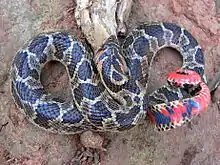Xenodontinae
Xenodontinae is a subfamily of snakes in the family Dipsadidae.[2][3]
| Xenodontinae | |
|---|---|
 | |
| A xenodontine snake, Xenodon dorbignyi | |
| Scientific classification | |
| Kingdom: | Animalia |
| Phylum: | Chordata |
| Class: | Reptilia |
| Order: | Squamata |
| Suborder: | Serpentes |
| Family: | Colubridae |
| Subfamily: | Xenodontinae Cope, 1895[1] |
The subfamily Xenodontinae encompasses a number of rear-fanged (opisthoglyphous), mildly venomous snake genera found in South America and the Caribbean. Members of the subfamily Xenodontinae are by definition closer relatives to the genus Xenodon than they are to the genus Dipsas. Some authors consider Xenodontinae and Dipsadinae to be synonymous. If the two names are used synonymously, then Dipsadinae is the correct name because it is older.[4]
Genera
- Alsophis (includes Dromicus)
- Apostolepis
- Arrhyton
- Boiruna
- Caaeteboia
- Calamodontophis
- Caraiba (formerly Antillophis)
- Clelia
- Conophis
- Ditaxodon Hoge, 1958
- Drepanoides
- Echinanthera
- Elapomorphus
- Erythrolamprus (includes Liophis and Umbrivaga)
- Gomesophis
- Helicops
- Hydrodynastes
- Hydrops
- Hypsirhynchus (includes Darlingtonia)
- Ialtris
- Lygophis
- Magliophis
- Manolepis
- Mussurana
- Oxyrhopus
- Phalotris
- Philodryas (including Pseudablabes)
- Phimophis
- Pseudalsophis
- Pseudoboa Schneider, 1801
- Pseudoeryx
- Pseudotomodon
- Psomophis
- Ptychophis
- Rhachidelus
- Saphenophis
- Siphlophis
- Tachymenis
- Taeniophallus
- Thamnodynastes
- Tomodon
- Tropidodryas
- Uromacer
- Xenodon (includes Lystrophis and Waglerophis)
When used as a subfamily of Dipsadidae, Xenodontinae does not include genera placed in the subfamily Dipsadinae (e.g. Dipsas, Sibon, Coniophanes, Atractus, Geophis, Hypsiglena, Imantodes, Leptodeira, Ninia, Rhadinaea, Urotheca) nor the North American relict genera (Heterodon, Farancia, Diadophis, Carphophis, Contia), nor the Asian genus Thermophis, because these are too distantly-related to Xenodon.[2][3]
References
- "Xenodontinae". ITIS (Integrated Taxonomic Information System). www.itis.gov.
- Grazziotin, Felipe G.; Zaher, Hussam; Murphy, Robert W.; Scrocchi, Gustavo; Benavides, Marco A.; Zhang, Ya-Ping; Bonatto, Sandro L. (2012). "Molecular phylogeny of the New World Dipsadidae (Serpentes: Colubroidea): a reappraisal". Cladistics. 28 (5): 437–459. doi:10.1111/j.1096-0031.2012.00393.x.
- Zaher, H.; Grazziotin, F. G.; Cadle, J. E.; Murphy, R. W.; Moura-Leite, J. C.; Bonatto, S. L. (2009). "Molecular phylogeny of advanced snakes (Serpentes, Caenophidia) with an emphasis on South American Xenodontines: A revised classification and descriptions of new taxa". Papéis Avulsos de Zoologia (São Paulo). 49 (11): 115–153. doi:10.1590/s0031-10492009001100001.
- Pyron, R. A.; Burbrink, F. T.; Colli, G. R.; De Oca, A. N. M.; Vitt, L. J.; Kuczynski, C. A.; Wiens, J. J. (2011). "The phylogeny of advanced snakes (Colubroidea), with discovery of a new subfamily and comparison of support methods for likelihood trees" (PDF). Molecular Phylogenetics and Evolution. 58 (2): 329–342. doi:10.1016/j.ympev.2010.11.006. PMID 21074626.
Finally, we follow Zaher et al. (2009) in using the name Dipsadinae (Bonaparte, 1840) to refer to Xenodontinae (Bonaparte, 1845) of Lawson et al. (2005) and previous authors, based on priority.
| Wikimedia Commons has media related to Dipsadidae. |